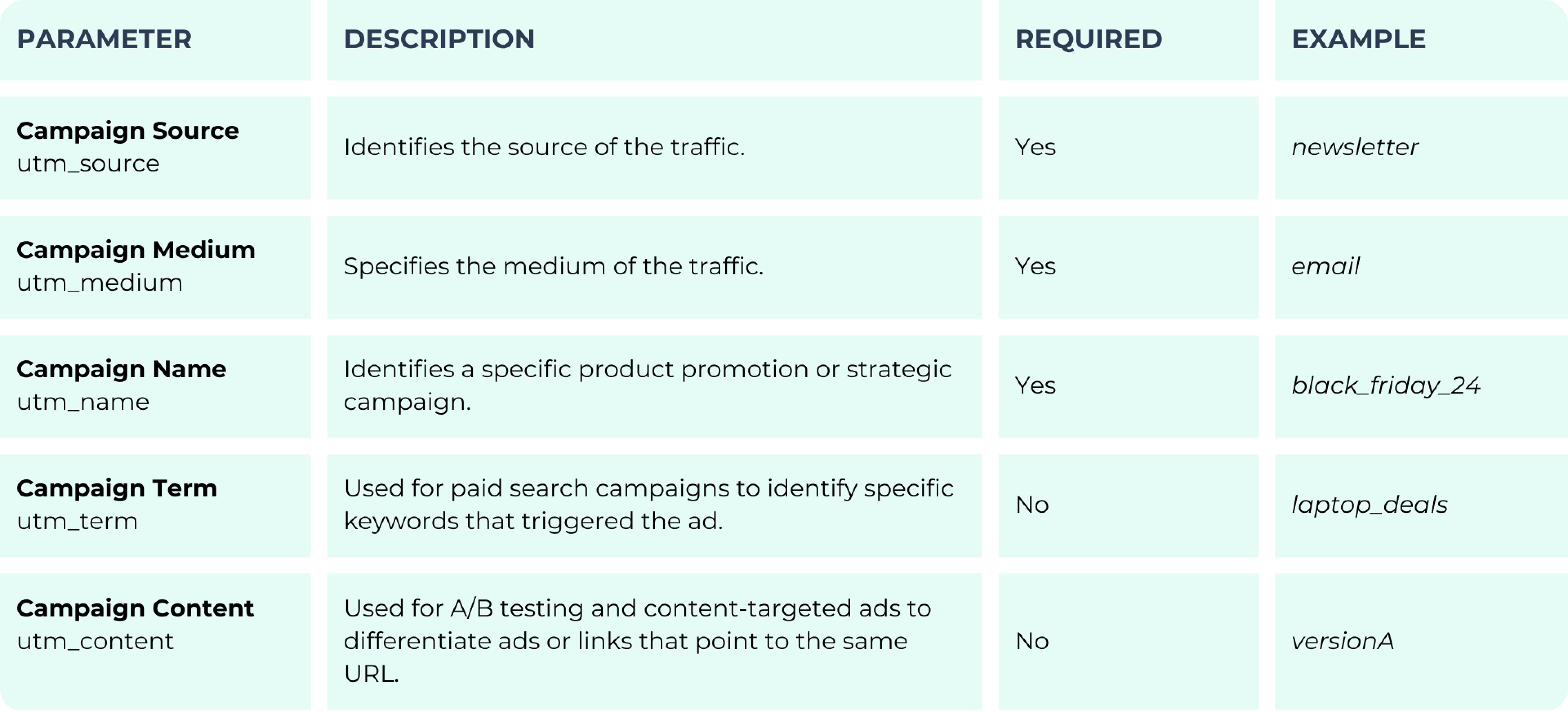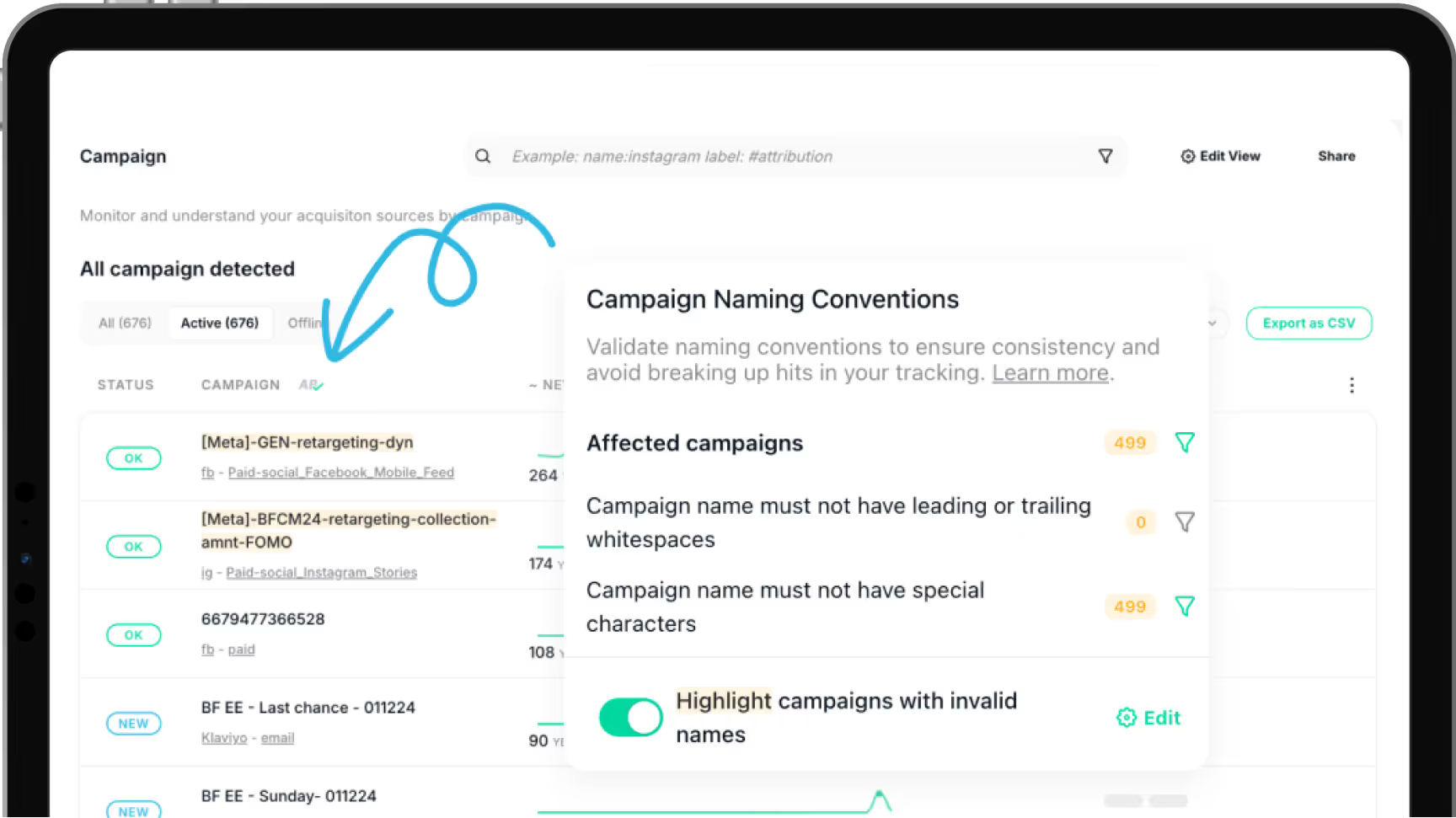What Are UTM Parameters and Why Are They Important?
UTM parameters are short text codes added to URLs that track the effectiveness of digital marketing campaigns. By understanding which channels drive the most valuable traffic, you can make data-driven decisions that optimize ad spend, refine marketing strategies, and boost overall campaign effectiveness.
UTMs allow marketing teams to look for trends and patterns that work to be able to allocate resources effectively. This is how you’ll be able to reliably credit conversions to the correct traffic source to know the true Cost Per Acquisition (CPA) and the Return On Ad Spend (ROAS) for each of your marketing efforts.
Benefits of Using UTM Codes
UTM parameters provide you with the clarity you need to understand your audience and tailor your marketing efforts for optimal results.
- Clear Campaign Tracking: Easily measure the performance of each campaign.
- Better Budget Allocation: Identify the best-performing channels for smarter budget distribution.
- Enhanced Attribution Accuracy: See which sources, media, and content drive the most conversions.
- Improved Marketing ROI: Make informed decisions that maximize your return on marketing spend.
Step-by-Step Guide to Creating Effective UTM Codes
Trackingplan’s UTM Builder Tool makes it quick and easy to build URLs with UTM codes, allowing you to set up precise tracking for all your marketing campaigns effortlessly.
To generate your UTM codes, all you need to do is follow these easy steps in Trackingplan’s UTM builder:
- Enter Your Destination URL: Start by pasting the URL of the webpage you want to track, such as a website, a blog post, or a landing page.
- Fill in Required Fields: Next, fill out the required fields with the values you’ve specified for the campaign source, medium, and campaign name.
- Add Additional Parameters: If needed, fill out the optional parameters for more detailed tracking.
- Instant URL Preview and Copy: Once you’ve entered all the fields, click the “Build URL” button to automatically generate your free UTM code. Here, the real-time preview will allow you to see exactly how your URL looks before copying it. Finally, just click the ‘Copy URL’ button to copy the generated URL.
- Share and Track Your Campaign: Use your custom URL across campaign channels—emails, social media posts, ads, and more. As traffic flows in, your analytics tools will capture this detailed data, allowing you to monitor campaign performance, identify top channels, and optimize for better results.
UTM Tracking Made Easy: A Guide to Effective Campaign Tracking
For more detailed insights into how UTM tracking works, this section breaks down each UTM parameter—its purpose, best practices, and tips for maximizing tracking accuracy. Understanding these campaign tracking parameters will help you gain clearer, more actionable insights from your campaigns, allowing you to make data-driven marketing decisions with confidence.
Campaign Source (Required)
The source parameter helps identify where traffic is coming from, such as “Google” or “Newsletter.”
This parameter complements the medium by offering more granularity about the origin of website traffic. For instance, given that 'social' can represent various platforms, the source parameter is where you’ll be able to specify and narrow down the specific platform your visitors originated from (Facebook, Twitter, LinkedIn, Instagram, etc.). Combining source and medium facilitates filtering and grouping of traffic for better analysis, allowing you to compare different marketing forms within the same platform.
Campaign Medium (Required)
This parameter defines which medium your visitors are using when visiting your website. This could be “paid-social”, in case you’re planning to launch a paid campaign on one of your social networks, “email”, or “cpc” to distinguish between channels and understand which ones perform best.
This parameter is key to identifying which medium drives the most valuable traffic to your website and answering where you acquired your users from.
Campaign Name (Required)
The campaign parameter is crucial for accurately tracking website traffic, indicating the specific marketing campaign, promotion, or ad that triggered your visitors’ clicks. Given the multitude of campaigns that marketing teams typically handle simultaneously, this parameter provides the necessary detail to track and compare individual campaign performance.
However, managing campaign parameters can be challenging due to the potentially vast number of campaigns. That is why using unique and consistent naming conventions is key in getting their full reporting value, as this allows the whole team to understand and use them correctly and consistently, rather than falling into that vicious cycle of disorganization.
Campaign Term (Optional)
This is particularly useful for paid search campaigns to track specific keywords. By tagging your URLs with precise terms—like “winter_boots” for seasonal promotions or “best_laptops” for high-competition products—you'll gain detailed insights into which keywords are driving traffic to your site. This enables you to optimize your campaigns effectively, pinpointing which search terms contribute to conversions. This granular tracking also helps you measure the ROI of each keyword, refine your ad strategy, and maximize budget allocation toward high-performing terms.
Campaign Content (Optional)
The Campaign Content parameter, or "utm_content," is an optional UTM tag that helps you distinguish between different ads, links, or creative elements within the same campaign or links that point to the same URL. This parameter is especially useful for A/B testing and optimizing ad performance, as it enables you to see which specific versions of your content resonate best with your audience.
For a clearer understanding, the table below provides an overview of each campaign parameter, complete with examples and concise descriptions:

Common Mistakes and Best Practices in UTM Tracking
UTM codes are essential for tracking the effectiveness of your marketing campaigns, but mistakes in their usage can lead to skewed or misleading data. Moreover, considering that mistakes in UTM parameters are permanent, and that even a single misplaced character—such as a typo or inconsistent capitalization—can compromise your data's integrity to the point of making it useless, consistency in naming conventions is absolutely essential.
Follow these best practices to ensure your UTM tracking is accurate, consistent, and insightful.
What should you consider when building UTM codes?
Also, when creating a campaign name, several factors should be considered to ensure effectiveness, clarity, and consistency in campaign tracking and analysis. In this regard, understanding how to name a campaign and establishing strong naming conventions is key for effectively leveraging your marketing campaigns.
- Standardize Your UTM Naming Conventions: Keeping UTM codes organized with standardized naming conventions ensures your data is consistent and clear. A disorganized or inconsistent naming system can easily ruin the integrity of your data.
- Avoid Adding UTM Tags to Internal Links: UTM codes are meant for tracking external traffic sources, so using them on internal links can skew data, leading to misleading metrics. Use UTMs strictly for tracking inbound traffic to ensure accurate insights.
- Avoid Spaces and Special Characters: Spaces and special characters can interfere with how UTM codes are interpreted by analytics tools. Replace spaces with dashes or underscoresto maintain clarity and ensure compatibility across analytics platforms.
- Use Consistent Naming and Descriptive Terms Across Campaigns: Choose terms that are descriptive and easy to understand, applying the same terminology across all campaigns. This consistency simplifies analysis, helping you to assess campaign performance more accurately.
- Maintain Consistent Capitalization: It’s best to use lowercase for UTM parameters to avoid confusion and potential data fragmentation. Variations in capitalization, like "Email" versus "email," can split tracking data, leading to inconsistent reports.
- Stick to Consistent Values: For example, if you’re using "twitter" for a social media campaign, don’t alternate with "Twitter" or abbreviations like "tw." Consistency in value naming helps you avoid fragmented data, ensuring your reports are comprehensive and actionable.
- Validate the Structure of Your URLs: Make sure the URL is well-structured without parsing issues. Check for any unnecessary symbols, like stray
&symbols, or terms like "http" or "https" accidentally added to campaign names. These issues can break the UTM string or prevent analytics tools from reading it correctly. - Ensure utm_medium and utm_source Fields Aren't Empty: Leaving medium or source fields empty will prevent accurate source tracking. Both fields are essential for understanding where traffic is coming from, so always ensure they are filled out properly.
Common UTM Mistakes and How to Avoid Them
UTM codes are powerful but must be used correctly to ensure data accuracy. Here are common mistakes and how to fix them:
- Over-Tagging: Adding too many parameters can make tracking confusing. Stick to only necessary parameters for each campaign.
- Quick Fix: Use only the essential fields: source, medium, and campaign name.
- Inconsistent Naming: Using different terms for the same source or medium can fragment your data.
- Quick Fix: Standardize terms (e.g., if you use
facebook, then don’t usefbor other variations).
- Quick Fix: Standardize terms (e.g., if you use
- No Naming Conventions: Without a strategy, UTM codes can become chaotic, making it hard to analyze.
- Quick Fix: Create a UTM naming guide for your team.
By avoiding these mistakes, you ensure that your UTM data is accurate, actionable, and easy to interpret.
Tips and Recommendations in UTM Tracking
When setting up your UTMs, ensure consistency in your naming conventions across all campaigns. This includes standardizing UTM parameters like utm_source and utm_medium to maintain clean and accurate data. To ensure accurate tracking, avoid using spaces or special characters in your UTM parameters to prevent tracking issues.
A disorganized system of UTM parameters can easily ruin the integrity of your analysis data. To change this, maintaining a standardized approach to UTM tagging across all campaigns for reliable data collection is key. Moreover, automated tools like Trackingplan can also help you set up validation rules for your UTMs to enforce your naming conventions across the different teams that deal with traffic acquisition.
By considering these factors, marketers can create campaign names that facilitate effective tracking, analysis, and understanding of marketing efforts. This approach leads to more accurate reporting and better-informed decision-making. For more information about campaign tagging, campaign parameters, and UTM naming conventions, keep exploring our FAQ resources.















%252520(1)%252520(1).png)

